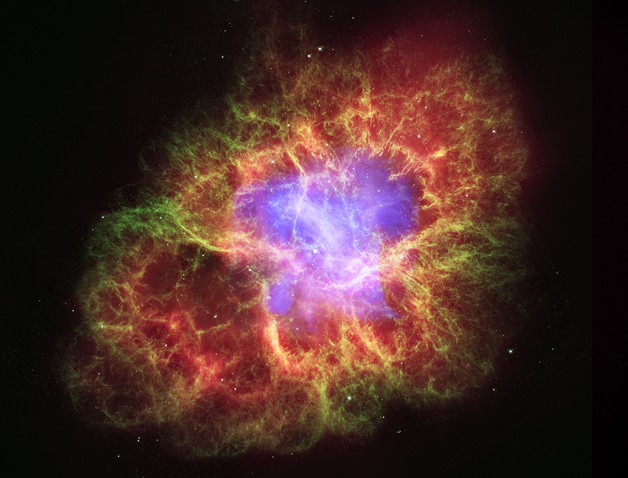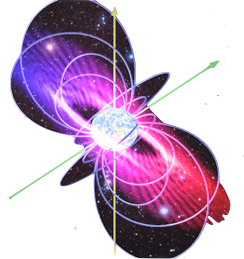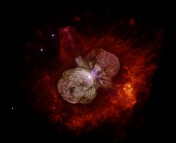- Title: Three-Dimensional Explosion Geometry of Stripped-Envelope Core-Collapse Supernovae. I. Spectropolarimetric Observations
- Authors: M. Tanaka, K. S. Kawabata, T. Hattori, P. A. Mazzali, K. Aoki, M. Iye, K. Maeda, K. Nomoto, E. Pian, T. Sasaki, and M. Yamanaka
- First Author’s Institution: National Astronomical Observatory, Mitaka, Tokyo, Japan
Supernovae (SNe) are important endpoints of stellar evolution, play a significant role in enriching the interstellar medium with higher mass elements, and trigger the formation of stars through their expanding shock waves. Not only do core-collapse SNe play important roles in the universe, but in the study of astronomy as well. Their intrinsic luminosity has helped astronomers determine that the universe is expanding. Thus SNe play key roles across the spectrum of astronomy.
Being such useful tools, SNe have been studied with modern scientific methods for nearly a century. In order to make calculations feasible, theoretical studies of SNe assume that these cataclysmic explosions are spherically symmetric. But are they? The surroundings and debris produced from SN 1987A are asymmetric. The supernova remnant Cassiopeia A shows signs of a jet and counterjet which have disrupted the expanding shell of debris.
While recent research shows that SNe are aspherical, the question remains: is this asymmetry merely incidental or is it a vital clue to the explosion mechanism behind SNe? Tanaka et al. used spectropolarimetric measurements to observe two stripped-envelope SNe. (i.e. SNe without a H-rich layer). The fact that these objects have been stripped of their outer layers means that we are looking deeper into the heart of the exploding star. We hope that by studying these objects, we may understand more about the explosion mechanism itself.
The team finds that both objects show significant departures from spherical symmetry. In other words: aspherical 3D geometry is common in stripped-envelope SNe. Thus it is likely that the explosion mechanism itself is aspherical.
The Power of Spectropolarimetry
The most direct method of obtaining observational constraints on the multi-dimensional geometry of SNe is simply to look at spatially resolved SNe. Such direct imaging, however, is limited. Most SNe are very distant and therefore appear to be point sources. With few SNe close enough to be spatially resolvable, we cannot do a resolved study with a sizeable sample. For unresolved SNe, spectropolarimetry is a powerful tool to study their morphologies.
Polarization describes the orientation of a light wave’s oscillating electric field. In pure linear polarization, the orientation of the electric field is in a single direction. Such linear polarization is due primarily to scattering. It will in turn tell us about the scattering materials orientation. Circular polarization occurs when the direction of the electric field rotates as the wave travels, caused primarily by synchrotron radiation.

Figure 1 – A schematic of polarization in the SN ejecta. (a) When the photosphere is spherical, the polarization vectors cancel out. (b) When the ion distribution is spherical, the remaining polarization is still cancelled out. (c) When the ion distribution is not spherical, the cancellation is incomplete, and the line polarization is not zero.
The intensity and state of polarization is often parameterized by the four Stokes parameters: I, Q, U, and V. I is the total intensity of light, Q and U specify the amount of linear polarization along the position angles 0 and 45 degrees, respectively, and V indicates the amount of circular polarization. Typically these Stokes parameters are normalized with respect to the total intensity such that Q is actually Q/I and so forth. Spectropolarimetry is the measure of polarization as a function of wavelength.
When light scatters through the expanding debris of a supernova, it retains information about the orientation of these scattering layers, which can then be studied using spectropolarimetric measurements. If the ejecta are distributed spherically, the polarization vectors cancel each other out, causing no polarization to be observed at any wavelength. Thus polarization is detected at a specific line if and only if the ejecta are distributed aspherically (see Figure 1).
Observations And Results
Tanaka et al. performed spectropolarimetric observations on two SNe (Type 1b and 1c) with the Faint Object Camera and Spectrograph (FOCAS) on the 8.2m Subaru telescope. They observed SNe 2009jf and SNe 2009mi at epochs corresponding to 9.3 and 26.5 days after maximum light, respectively. By placing a half-wave plate and a crystal quartz prism in the light’s optical path, and then rotating the half-wave plate, the team was able to measure the linear Stokes parameters Q and U.
The total observed polarization is the sum of the intrinsic, interstellar, and instrumental polarization. The geometry of the internal optics may lead to induced polarization, depolarization, and even “cross-talk” (when polarization as seen in one Stokes parameter transfers to another). The instrumental polarization (which in this case was approximately 0-0.4%) was evaluated and subtracted using unpolarized standard stars (well studied stars in which we know the polarization is zero and should be measured as such) observed on the same night.
Interstellar polarization (ISP) occurs when the light scatters off interstellar dust both in our Galaxy and the host galaxy. However, the wavelength dependence of the ISP is well quantified based on observations of standard stars. It is primarily smooth in that it changes little across different absorption lines. Thus the observed changes in the polarization at different absorption lines are certainly intrinsic.

Figure 2 – The total flux spectrum and polarization spectrum of SNe 2009jf (left panel) and SN 2009mi (right panel). Note the differences in the Q and U polarization at the same spectral lines. The polarization data are binned into 25 and 50 A for SNe 2009jf and 2009mi, respectively.
The observed total flux and polarization can be seen in Figure 2. While the effects of ISP have not been taken into account in this plot, the changes in the polarization at the wavelengths of strong absorption lines such as He I, O I, and Ca II, are intrinsic. Note that the amount of polarization in the absorption lines O I and Ca II varies significantly across the Stokes parameters. This is caused by a complex structure in the SNe ejecta and will produce “loops” in the Q-U plane, as can be seen in Figure 3. Such loops are indicative of a 3D structure.

Figure 3 – Observed polarization data of SNe 2009jf (left panel) and SNe 2009mi (right panel) in the Q-U plane, Each data point depicts the level of Stokes Q and U polarization in a given 50 A window. Note the O I and Ca II loops.
These loops are functions of the wavelength across a line feature. As such they are also functions of the velocity and of the depth of the portion of the structure that contributes to that wavelength. For example, the O I polarization suggests that the photosphere has receded into the C/O-rich core. Because these loops represent changes in the amplitude and angle of polarization as a function of wavelength, velocity, and depth, they are evidence for asymmetry. They may be caused by clumps of O I and Ca II or other structures.
Both SNe are stripped-envelope SNe, i.e. SNe without their outer hydrogen layers. These SNe allow us to see deeper into the exploding star. Tanaka et al. compared their results to spectropolarimetric observations of four other stripped-envelope SNe, and found that all of them show non-zero polarization and loops in Q-U space. This is strong evidence for the idea that core collapse routinely involves an intrinsically strongly aspherical explosion mechanism.
Conclusions
Tanaka et al. performed spectropolarimetric observations of two stripped-envelope SNe, Type 1b SN 2009jf and Type 1c SN 2009mi. Both objects show non-zero line polarization at the wavelength of strong absorption lines as well as a “loop” in the Q-U diagram. This indicates asymmetry. They compare their data with the sample of stripped-envelope SNe, and find that their results are common among all observed stripped-envelope SNe.
In conclusion, It is likely that the mechanism that drives core-collapse SNe must produce energy and momentum aspherically from the beginning, and then hold that orientation long enough for its imprint to be frozen into the expanding matter. Matter could be ejected in clumps that block the photosphere in several different lines. These may be induced by jet-like flows. While the exact mechanism is still unknown, it is clear that the cause for an aspherical geometry lies deep in the ejecta, beneath the hydrogen layers, and certainly in the explosion mechanism itself.
Further studies will include gathering a larger data sample. We need to perform high-quality spectropolarimetric observations on more than 6 stripped-envelope SNe. It will also be useful to observe these objects at different epochs. How does the polarization and therefore asymmetry change with time? If it decreases this may be further evidence that the explosion mechanism itself is asymmetric. Only time will tell.





Very cool post, my mind is running wild with ideas now.